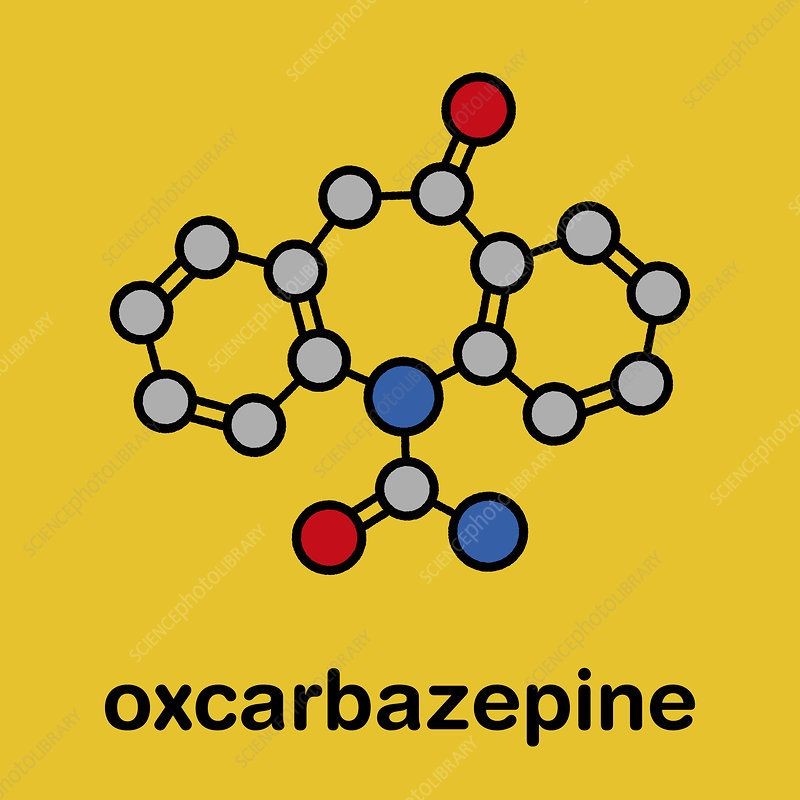
Contents
oxcarbazepine
Seizures are caused by abnormal electrical activity in the brain. Partial or focal seizures occur when this abnormal activity is limited to a specific area of the brain. Oxcarbazepine is used to treat bipolar disorder and nerve pain (neuralgia) and damage (neuropathy) resulting from certain neurological diseases.
Oxcarbazepine reduces the incidence and frequency of seizures by inhibiting abnormal electrical activity in the brain. It works by blocking voltage-sensitive sodium channels, stabilizing nerve cell membranes, and reducing excitability. This helps to inhibit repetitive neuronal firing and the spread of nerve impulses. Oxcarbazepine also enhances potassium conductance and modulates calcium channel activity.
Oxcarbazepine’s immediate release formulation is approved by the FDA as monotherapy for adults and children aged 4-16 and as adjunctive therapy for children aged 2-16. The extended-release formulation is approved for patients aged 6 and older. Off-label uses in adults include:
4 off-label uses for oxcarbazepine
- Trigeminal neuralgia
- Bipolar disorder
- Neuralgia/neuropathy
- Diabetic neuropathy
Warnings
- Do not use oxcarbazepine in patients with hypersensitivity to oxcarbazepine, its components, or eslicarbazepine acetate.
- Oxcarbazepine is structurally similar to carbamazepine. Exercise caution in patients hypersensitive to carbamazepine.
- Hypersensitivity symptoms may include angioedema and anaphylaxis. Discontinue oxcarbazepine immediately if signs of hypersensitivity develop.
- Oxcarbazepine may cause serious dermatologic reactions, such as Stevens-Johnson syndrome (SJS) and toxic epidermal necrolysis (TEN). Discontinue and consider alternate therapy if skin reactions occur.
- Oxcarbazepine may lower sodium levels and cause hyponatremia and syndrome of inappropriate antidiuretic hormone secretion (SIADH). Monitor sodium levels, especially when using other medications that decrease sodium levels.
- Oxcarbazepine and other antiepileptic drugs may increase the risk of suicidal thoughts and behavior. Caution patients, families, and caregivers.
- Withdraw oxcarbazepine gradually to avoid increased seizure frequency or status epilepticus.
- Oxcarbazepine may impair cognitive and motor skills and cause drowsiness and fatigue. Caution patients to avoid hazardous activities.
- Oxcarbazepine may cause drug reactions with eosinophilia and systemic symptoms (DRESS), or multi-organ hypersensitivity. Discontinue if symptoms occur without alternative causes.
- Rare reports of reduced blood cell counts. Monitor patients for symptoms.
- MHD levels may decrease during pregnancy. Monitor patients closely during pregnancy and postpartum.
- Concurrent use of oxcarbazepine and hormonal contraceptives may reduce efficacy. Caution patients.
- Reports of primary generalized seizure aggravation or onset with oxcarbazepine treatment. Discontinue if seizures worsen.
- Reports of hypothyroidism with oxcarbazepine. Monitor thyroid function.
- Patients with impaired kidney function may require dose adjustment.
- Immediate-release and extended-release formulations are not bioequivalent.
- Caution with formulations containing propylene glycol, which can be toxic in large amounts.
Side effects of oxcarbazepine
Common side effects include:
- Drowsiness (somnolence)
- Dizziness
- Impaired coordination, balance, and speech (ataxia)
- Abnormal gait
- Tremor
- Fatigue
- Headache
- Vertigo
- Nausea
- Vomiting
- Abdominal pain
- Diarrhea
- Constipation
- Indigestion (dyspepsia)
- Gastritis
- Loss of appetite (anorexia)
- Dry mouth
- Rectal hemorrhage
- Toothache
- Low blood sodium levels (hyponatremia)
- Thirst
- Double vision (diplopia)
- Abnormal vision
- Repetitive uncontrolled eye movements (nystagmus)
- Abnormal eye focusing (accommodation)
- Taste perversion
- Earache
- Ear infection
- Acne
- Rash
- Flat, red, raised lesions (maculopapular rash)
- Bruising and purple spots (purpura)
- Hot flushes
- Increased sweating
- Reduced skin sensation (hypoesthesia)
- Insomnia
- Abnormal thinking
- Agitation
- Nervousness
- Confusion
- Difficulty concentrating
- Memory loss (amnesia)
- Mood swings (emotional lability)
- Aggravated convulsions
- Involuntary muscle contractions
- Abnormal EEG
- Cranial injury
- Muscle weakness
- Sprains and strains
- Back pain
- Falling down
- Fever
- Weakness (asthenia)
- Feeling abnormal
- Leg swelling (edema)
- Generalized edema
- Increase in weight
- Allergy
- Chest pain
- Low blood pressure (hypotension)
- Upper respiratory tract infection
- Pneumonia
- Cough
- Nosebleed (epistaxis)
- Nasal inflammation (rhinitis)
- Sinus inflammation (sinusitis)
- Throat inflammation (pharyngitis)
- Bronchial inflammation (bronchitis)
- Infection
- Viral infection
- Chest infection
- Lymph node swelling (lymphadenopathy)
- Urinary tract infection
- Urinary frequency
- Vaginal inflammation (vaginitis)
Serious side effects include:
- Swelling of tissue under the skin and mucous membranes (angioedema)
- Severe allergic reaction (anaphylaxis)
- Serious skin reactions including Stevens-Johnson syndrome and toxic epidermal necrolysis
- Low count of leukocyte immune cells (leukopenia)
- Low count of granulocyte immune cells (agranulocytosis)
- Low count of all types of blood cells (pancytopenia)
- Low red blood cell count due to lack of production (aplastic anemia)
- Low platelet count (thrombocytopenia)
Less common side effects include:
- Palpitation
- Slow or rapid heart rate (bradycardia or tachycardia)
- Cardiac failure
- Fainting (syncope)
- Cerebral hemorrhage
- Low or high blood sugar (hypoglycemia/hyperglycemia)
- Low calcium (hypocalcemia)
- Low potassium (hypokalemia)
- Elevated liver enzymes
- Asthma
- Shortness of breath (dyspnea)
- Inflammation of lung’s lining (pleurisy)
- Drug-related movement disorders (extrapyramidal disorder)
- Migraine
- Ringing in ears (tinnitus)
- Delirium
- Delusions
- Psychosis
- Changes in libido
- Painful and prolonged erection (priapism)
- Painful urination (dysuria)
- Blood in urine (hematuria)
- Excessive urination (polyuria)
- Kidney stone
- Intermenstrual bleeding
- Excessive menstrual bleeding (menorrhagia)
- White discharge (leukorrhea)
- Systemic lupus erythematosus
Contact your doctor immediately if you experience any of the following symptoms or serious side effects while using this drug:
- Serious heart symptoms such as fast or pounding heartbeats, fluttering in your chest, shortness of breath, and sudden dizziness
- Severe headache, confusion, slurred speech, severe weakness, vomiting, loss of coordination, feeling unsteady
- Severe nervous system reaction with very stiff muscles, high fever, sweating, confusion, fast or uneven heartbeats, tremors, and feeling like you might pass out
- Serious eye symptoms including blurred vision, tunnel vision, eye pain or swelling, or seeing halos around lights
This is not a complete list of all side effects or adverse reactions. Contact your doctor or report side effects or health problems to the FDA at 1-800-FDA-1088.


